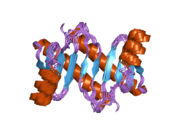DYNLRB1
Protein-coding gene in the species Homo sapiens
| DYNLRB1 | |||||||||||||||||||||||||||||||||||||||||||||||||||
|---|---|---|---|---|---|---|---|---|---|---|---|---|---|---|---|---|---|---|---|---|---|---|---|---|---|---|---|---|---|---|---|---|---|---|---|---|---|---|---|---|---|---|---|---|---|---|---|---|---|---|---|
 | |||||||||||||||||||||||||||||||||||||||||||||||||||
| |||||||||||||||||||||||||||||||||||||||||||||||||||
| Identifiers | |||||||||||||||||||||||||||||||||||||||||||||||||||
| Aliases | DYNLRB1, BITH, BLP, DNCL2A, DNLC2A, ROBLD1, dynein light chain roadblock-type 1 | ||||||||||||||||||||||||||||||||||||||||||||||||||
| External IDs | OMIM: 607167; MGI: 1914318; HomoloGene: 69161; GeneCards: DYNLRB1; OMA:DYNLRB1 - orthologs | ||||||||||||||||||||||||||||||||||||||||||||||||||
| |||||||||||||||||||||||||||||||||||||||||||||||||||
| |||||||||||||||||||||||||||||||||||||||||||||||||||
| |||||||||||||||||||||||||||||||||||||||||||||||||||
| |||||||||||||||||||||||||||||||||||||||||||||||||||
| |||||||||||||||||||||||||||||||||||||||||||||||||||
| Wikidata | |||||||||||||||||||||||||||||||||||||||||||||||||||
| |||||||||||||||||||||||||||||||||||||||||||||||||||
Dynein light chain roadblock-type 1 is a protein that in humans is encoded by the DYNLRB1 gene.[5][6][7]
This gene is a member of the roadblock dynein light chain family and encodes a cytoplasmic protein that is capable of binding intermediate chain proteins. Upregulation of this gene has been associated with hepatocellular carcinomas, suggesting that this gene may be involved in tumor progression.[7]
References
- ^ a b c GRCh38: Ensembl release 89: ENSG00000125971 – Ensembl, May 2017
- ^ a b c GRCm38: Ensembl release 89: ENSMUSG00000047459 – Ensembl, May 2017
- ^ "Human PubMed Reference:". National Center for Biotechnology Information, U.S. National Library of Medicine.
- ^ "Mouse PubMed Reference:". National Center for Biotechnology Information, U.S. National Library of Medicine.
- ^ Jiang J, Yu L, Huang X, Chen X, Li D, Zhang Y, Tang L, Zhao S (Dec 2001). "Identification of two novel human dynein light chain genes, DNLC2A and DNLC2B, and their expression changes in hepatocellular carcinoma tissues from 68 Chinese patients". Gene. 281 (1–2): 103–13. doi:10.1016/S0378-1119(01)00787-9. PMID 11750132.
- ^ Pfister KK, Fisher EM, Gibbons IR, Hays TS, Holzbaur EL, McIntosh JR, Porter ME, Schroer TA, Vaughan KT, Witman GB, King SM, Vallee RB (Nov 2005). "Cytoplasmic dynein nomenclature". J Cell Biol. 171 (3): 411–3. doi:10.1083/jcb.200508078. PMC 2171247. PMID 16260502.
- ^ a b "Entrez Gene: DYNLRB1 dynein, light chain, roadblock-type 1".
Further reading
- Zhang QH, Ye M, Wu XY, et al. (2001). "Cloning and Functional Analysis of cDNAs with Open Reading Frames for 300 Previously Undefined Genes Expressed in CD34+ Hematopoietic Stem/Progenitor Cells". Genome Res. 10 (10): 1546–60. doi:10.1101/gr.140200. PMC 310934. PMID 11042152.
- Deloukas P, Matthews LH, Ashurst J, et al. (2002). "The DNA sequence and comparative analysis of human chromosome 20". Nature. 414 (6866): 865–71. Bibcode:2001Natur.414..865D. doi:10.1038/414865a. PMID 11780052.
- Susalka SJ, Nikulina K, Salata MW, et al. (2002). "The roadblock light chain binds a novel region of the cytoplasmic Dynein intermediate chain". J. Biol. Chem. 277 (36): 32939–46. doi:10.1074/jbc.M205510200. PMID 12077152.
- Strausberg RL, Feingold EA, Grouse LH, et al. (2003). "Generation and initial analysis of more than 15,000 full-length human and mouse cDNA sequences". Proc. Natl. Acad. Sci. U.S.A. 99 (26): 16899–903. Bibcode:2002PNAS...9916899M. doi:10.1073/pnas.242603899. PMC 139241. PMID 12477932.
- Huang YS, Carson JH, Barbarese E, Richter JD (2003). "Facilitation of dendritic mRNA transport by CPEB". Genes Dev. 17 (5): 638–53. doi:10.1101/gad.1053003. PMC 196011. PMID 12629046.
- Gevaert K, Goethals M, Martens L, et al. (2004). "Exploring proteomes and analyzing protein processing by mass spectrometric identification of sorted N-terminal peptides". Nat. Biotechnol. 21 (5): 566–9. doi:10.1038/nbt810. PMID 12665801. S2CID 23783563.
- Saito Y, Doi K, Yamagishi N, et al. (2004). "Screening of Hsp105alpha-binding proteins using yeast and bacterial two-hybrid systems". Biochem. Biophys. Res. Commun. 314 (2): 396–402. doi:10.1016/j.bbrc.2003.12.108. PMID 14733918.
- Lehner B, Sanderson CM (2004). "A Protein Interaction Framework for Human mRNA Degradation". Genome Res. 14 (7): 1315–23. doi:10.1101/gr.2122004. PMC 442147. PMID 15231747.
- Gerhard DS, Wagner L, Feingold EA, et al. (2004). "The Status, Quality, and Expansion of the NIH Full-Length cDNA Project: The Mammalian Gene Collection (MGC)". Genome Res. 14 (10B): 2121–7. doi:10.1101/gr.2596504. PMC 528928. PMID 15489334.
- Rual JF, Venkatesan K, Hao T, et al. (2005). "Towards a proteome-scale map of the human protein-protein interaction network". Nature. 437 (7062): 1173–8. Bibcode:2005Natur.437.1173R. doi:10.1038/nature04209. PMID 16189514. S2CID 4427026.
- Campbell IG, Phillips WA, Choong DY (2006). "Genetic and epigenetic analysis of the putative tumor suppressor km23 in primary ovarian, breast, and colorectal cancers". Clin. Cancer Res. 12 (12): 3713–5. doi:10.1158/1078-0432.CCR-06-0800. PMID 16778097. S2CID 24551435.
- Pérez-González A, Rodriguez A, Huarte M, et al. (2007). "hCLE/CGI-99, a human protein that interacts with the influenza virus polymerase, is a mRNA transcription modulator". J. Mol. Biol. 362 (5): 887–900. doi:10.1016/j.jmb.2006.07.085. PMID 16950395.
- Liu JF, Wang ZX, Wang XQ, et al. (2006). "Crystal structure of human dynein light chain Dnlc2A: structural insights into the interaction with IC74". Biochem. Biophys. Res. Commun. 349 (3): 1125–9. doi:10.1016/j.bbrc.2006.08.161. PMID 16970917.
- Kang HC, Kim IJ, Kim K, et al. (2007). "km23, a transforming growth factor-beta signaling component, is infrequently mutated in human colorectal and gastric cancers". Cancer Genet. Cytogenet. 175 (2): 173–4. doi:10.1016/j.cancergencyto.2007.02.004. PMID 17556076.
- Wanschers B, van de Vorstenbosch R, Fransen J, et al. (2008). "Rab6 family proteins interact with the dynein light chain protein DYNLRB1". Cell Motil. Cytoskeleton. 65 (3): 183–96. doi:10.1002/cm.20254. PMID 18044744.
External links
- Overview of all the structural information available in the PDB for UniProt: Q9NP97 (Dynein light chain roadblock-type 1) at the PDBe-KB.
- v
- t
- e
PDB gallery
-
 1y4o: Solution structure of a mouse cytoplasmic Roadblock/LC7 dynein light chain
1y4o: Solution structure of a mouse cytoplasmic Roadblock/LC7 dynein light chain -
 1z09: Solution structure of km23
1z09: Solution structure of km23 -
 2b95: Solution NMR structure of protein dynein light chain 2A, cytoplasmic; Northeast structural genomics consortium TARGET HR2106
2b95: Solution NMR structure of protein dynein light chain 2A, cytoplasmic; Northeast structural genomics consortium TARGET HR2106
 | This article on a gene on human chromosome 20 is a stub. You can help Wikipedia by expanding it. |
- v
- t
- e




















